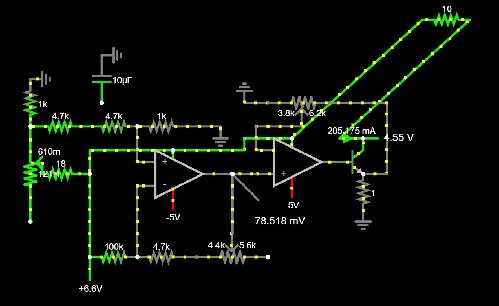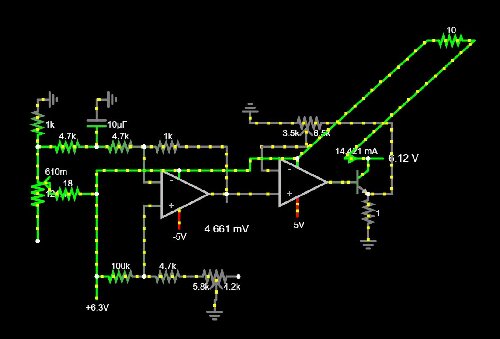Re: 48-50 Bimetal Senders Retrofit Project
Posted by humanpotatohybrid On 2024/5/5 13:35:46
Thanks Howard. Yes, I'm going to add some basic EMF protection. Dang EMF's.
I've come up with something here that should work well. The sender is represented as a potentiometer on the right. It is connected to +6.3V (car ground) and the other side is the circuit input. The 10u gives ripple/noise protection on the order of 50ms. The 4.7k+4.7k and 1k, then also the 100k and 4.7k+10k pot, form a differential amplifier with the left op amp. This basically inverts the signal. The pot is to "zero out" the signal depending on the sender minimum resistance. The second op amp is a simple amplifier whose gain is controlled by the pot above it. To set up this device, all you have to do is:
1: Hold the sender at "empty" (lowest resistance).
2: Set the first pot so the gauge reads empty.
3: Hold the sender at "full"
4: Set the second pot so the gauge reads full.
This works for a variety of gauges and senders, such as 0-100, 20-120, 30-330, etc. The values are pretty consistent over a varying input voltage; at least, not any more inconsistent than factory. This problem is naturally corrected on the later cars that have voltage regulators for the gauges. This one in particular gives a high output when for a high input (low resistance). [Type 1]

For systems where you need a low output for a high input (low resistance), there are some minor changes. [Type 2] Basically just to reverse the differential amplifier. Oh, and you must swap the words "empty" and "full" in the above instructions.

What I mean by high/low output and high/low reading is: for example, the 1955 fuel senders are 73 ohms empty and 10 ohms full. Obviously the fuel gauge will read low empty and high full. Likewise, since the current output of the sender is inversely proportional to the resistance, this means that a low sender output = a low gauge reading. So you need a "type 1" module.
So let's say you use the Ford unit in your 48-50. If you have no sender connected to the gas gauge, it reads low. Likewise, an empty tank gives a high resistance from the Ford sender. So you need a "type 1" module. However, let's then say that you find a comparable water temp sender that has high resistance when cold, but low when warm. If you hooked this to the fuel gauge it would read "correctly" but if you hooked it to the water temp gauge it would read "backwards". So you would need a "type 2" module.
Realistically I think I would package both a single "type 1" and "type 2" onto the same board since the individual component cost is so cheap, plus there needs to be additional power supply circuitry not shown so the overall cost difference would be negligible. Also, I've already found that with some minor tweaks you can use these on positive ground cars too.
I've come up with something here that should work well. The sender is represented as a potentiometer on the right. It is connected to +6.3V (car ground) and the other side is the circuit input. The 10u gives ripple/noise protection on the order of 50ms. The 4.7k+4.7k and 1k, then also the 100k and 4.7k+10k pot, form a differential amplifier with the left op amp. This basically inverts the signal. The pot is to "zero out" the signal depending on the sender minimum resistance. The second op amp is a simple amplifier whose gain is controlled by the pot above it. To set up this device, all you have to do is:
1: Hold the sender at "empty" (lowest resistance).
2: Set the first pot so the gauge reads empty.
3: Hold the sender at "full"
4: Set the second pot so the gauge reads full.
This works for a variety of gauges and senders, such as 0-100, 20-120, 30-330, etc. The values are pretty consistent over a varying input voltage; at least, not any more inconsistent than factory. This problem is naturally corrected on the later cars that have voltage regulators for the gauges. This one in particular gives a high output when for a high input (low resistance). [Type 1]

For systems where you need a low output for a high input (low resistance), there are some minor changes. [Type 2] Basically just to reverse the differential amplifier. Oh, and you must swap the words "empty" and "full" in the above instructions.

What I mean by high/low output and high/low reading is: for example, the 1955 fuel senders are 73 ohms empty and 10 ohms full. Obviously the fuel gauge will read low empty and high full. Likewise, since the current output of the sender is inversely proportional to the resistance, this means that a low sender output = a low gauge reading. So you need a "type 1" module.
So let's say you use the Ford unit in your 48-50. If you have no sender connected to the gas gauge, it reads low. Likewise, an empty tank gives a high resistance from the Ford sender. So you need a "type 1" module. However, let's then say that you find a comparable water temp sender that has high resistance when cold, but low when warm. If you hooked this to the fuel gauge it would read "correctly" but if you hooked it to the water temp gauge it would read "backwards". So you would need a "type 2" module.
Realistically I think I would package both a single "type 1" and "type 2" onto the same board since the individual component cost is so cheap, plus there needs to be additional power supply circuitry not shown so the overall cost difference would be negligible. Also, I've already found that with some minor tweaks you can use these on positive ground cars too.
This Post was from: https://packardinfo.com/xoops/html/modules/newbb/viewtopic.php?post_id=271152